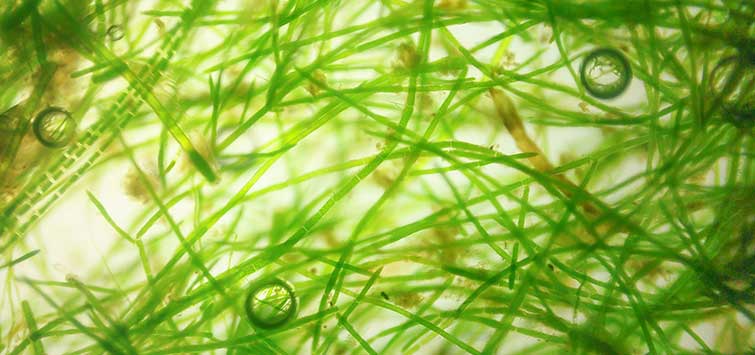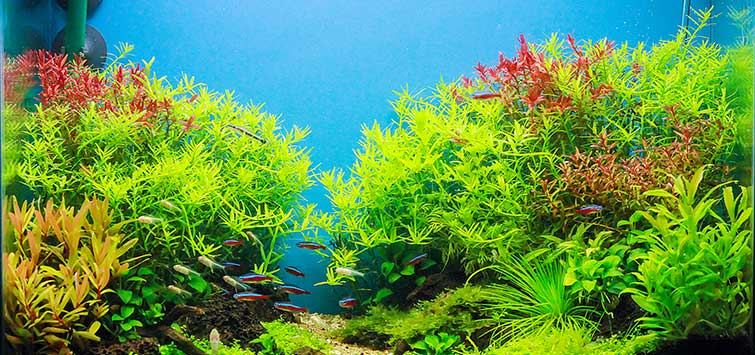The Planted Tank: What a Mess! Hair Algae in the Planted Tank
The Planted Tank: What a Mess! Hair Algae in the Planted Tank
Author: Rhonda Wilson
Hideous, hairy, stringy, matted, algae is the bane of the planted aquarium keeper. It can run all over the bottom of your tank and pull up your carpeting plants when you try to remove it. It can grow in huge nasty globs on the surface of your aquarium, cutting out light. It can fill your tank and even sometimes trap and kill your fish. Of all the types of algae, it’s hair algae that causes the most problems for the most aquarists.
SO WHAT EXACTLY IS HAIR ALGAE?
There are a number of algae species that grow into a hairy nasty mess. It’s difficult to specifically identify algae because there are so many kinds and they can look very similar. New types are discovered regularly, and there’s a lack of good reference materials with which to identify algae. In fact, algae is so diverse that some types are more closely related to fungus or animals than plants. If you think crypts, vals, and swords are hard to identify, try getting a good specific identification of your algae. Actually, your nasty ball of hair algae may contain several different species of algae. For the most part, then, we have to talk about algae in general terms and descriptions.
The hair algae I’ll be discussing in this month’s column can refer to any of the long, stringy, nasty, green algae that can invade your aquarium. Algae is often discussed in terms of its color, which is caused by its pigmentation. Chlorophyll is a pigment whose predominance makes most plants and green algae green. Green algae can have other pigments, but they have more chlorophyll. Even within the group of green algae, the organisms are not necessarily closely related. And even when two types of hair algae look the same, they may not be related, and different forms of treatment may be more effective for each type. You may have to experiment with several options before finding something that works.
WHERE DOES IT COME FROM?
Algae can come into your tank from many sources. Anything that goes into your tank that has been in another aquarium or natural body of water could potentially have algae on it. This includes plants, fish, snails, or any other living thing in your aquarium—including the water they came in with. Fish, shrimp, and most animals will be your least likely culprits. The shells of snails often have algae growing on them. Plants, as well as any decorations and equipment that have been in another aquarium, will most likely have some types of algae growing on them. There is even debate in the aquarium community as to what extent airborne spores might play in bringing algae in to the aquarium. Algae is very small and can come in to your tank from many sources.
REDUCING HAIR ALGAE
Manual Removal: The first thing you can do in your battle against hair algae is to remove as much as you can manually. Depending on how much you have in your tank, what kind it is, and if and where it’s attached, this can be a little difficult. If your plants have hair algae attached, you can pull them out of the tank to make it easier to manually remove the unwanted mess. Removing the hair algae will often take two hands, one to hold down your plant and one to pull off the algae. You can also remove parts of the plants that are heavily infested, but you don’t want to remove too much of the plants, as they are the warriors in your battle. Good healthy plants are a key to getting rid of algae.
Water Changes and Parameter: I like water changes as a next step. Most aquarium authors encourage water changes. If you have a problem with the buildup of excess nutrients, water changes will help that. Depending on the water you use, it should also add some micro-nutrients to the tank. If you need some pointers for performing water changes and other aquarium tasks, our friends at KaveMan Aquatics provide a variety of tutorials and other great resources.
Plants like to get used to one particular environment and stay that way. Changes mean their old leaves are no longer optimal for their surroundings; the more change, the more they need to drop old leaves and grow new ones. When they have to do that, they spend a lot more energy, and the old leaves start decomposing and adding to the problem.
But I still believe that regular water changes in any tank are good. Twenty years ago I was in the lesser-water-changes crowd, but some friends convinced me to try doing more water changes. I gave it a try and now believe my fish and plants have done better because of it—so I have switched sides and now advocate regular water changes. I think the benefits outweigh the possible disadvantages. If you do them regularly, they won’t cause huge swings in your tank.
Speaking of water, what’s yours like? In her book Ecology of the Planted Aquarium (Echinodorus Publishing, 2003), Diana Walstad indicates that algae have the advantage in water that’s alkaline and has a high pH. If you have naturally soft water out of the tap, that’s a great advantage for you. For those of us with water like liquid rock, there are other options. First you can purchase or filter your own water. RO water is often used in planted aquariums. Usually it is mixed with tap or several additives are mixed with it to achieve the desired water conditions. Adding CO2 will also lower your pH and can be very beneficial to the plants, but it does require more tank care.
Plant Selection and Growth: Another option—something that I do in the majority of my tanks—is to just grow plants that prefer the rock-like water. Many plants will do well in this type of water, including val, hornwort, swords, and mosses.
Regardless of what type of water you have, it’s always a good idea to research your plants. I can’t tell you how many times people will tell me of their plant-growing woes and then send me a photo of a dying house plant in an aquarium. Many emergent and even terrestrial plants are falsely sold as aquarium plants. Be sure to research your plants and fish before purchase, or be prepared to spend money on things that just won’t work. You need to have healthy aquatic plants to compete with your algae. New growth should be noticeable and should continue indefinitely.
Speaking of healthy plants, another method used to keep aquarium algae down relies on optimal plant growth. Planted-tank expert Tom Barr came up with a method known as “The Estimative Index” in which he states that fertilizers and CO2 combined with good lighting can maximize plant growth, thereby inhibiting the growth of algae. Doses are added daily to several times a week and large water changes are carried out weekly to ensure there are no excessive buildups. Results can be impressive, but this is a labor-intensive way to grow plants. You have to stay on top of it to keep the tank levels consistent, and you will need to trim regularly to keep up with excess plant growth.
Another way to use desirable plants to curb algae is by letting your plants grow across some of the top of the tank or even out of the tank. More plant growth means less for your algae, and plants growing across the top and out of the tank have the added benefit of being able to use the CO2 in the air. Plants at the top of your tank can also provide shade, which can hurt some algae. Just be sure to leave enough light so your plants don’t suffer.
Make sure you have adequate lighting for your aquarium, and replace bulbs frequently. Most sources cite six months to a year as a good time to change bulbs. Ensure that your aquarium isn’t getting sunlight from a window. Often a patch of hair algae can be linked to a passing period of daylight that streams in to a tank from an open window across the room.
Algae Grazers: Good aquarium practices are a key in fighting hair algae, but you also may wish to employ a small clean-up crew to aid in your battle. Several fish and invertebrates will eat at least some species of hair algae. Some of the ones that I’ve found to be successful are Florida flagfish Jordanella floridae, Ameca splendens, and some mollies. Though most shrimp don’t seem to eat the hair algae, I’ve found that ghost shrimp often will. And if you want to try something really unusual, the tiny Gammarus crustaceans will also eat it.
Mollies are often available at local fish stores, but the other fish may be hard to find. Look for people interested in livebearers or native fish; the ALA and NANFA are good places to start looking. You can also check online for auctions or shops, or ask your local stores if they can order them for you.
Ghost shrimp can often be purchased at many aquarium shops. They are often sold as feeder shrimp. They usually do very well in the planted aquarium with smaller fish. They even breed in the aquarium, readily carrying their eggs and young fry under their bodies, and eventually releasing tiny replicas of themselves.
Gammarus and the very similar-looking Hyella are tiny freshwater shrimp. They are easiest to find in a local body of water. They are often in ponds (both natural and manmade), plants purchased at nurseries that sell pond plants, and in many if not most natural bodies of water. Some fish will eat them, but I’ve found that with small fish in the tank enough Gammarus survive. Unfortunately you won’t be able to grow mosses in a tank with these fish, as they see it as an appetizing meal.
A SLOW AND STEADY BATTLE
You may notice that there are several different methods for dealing with the growth of unwanted hair algae in the aquarium. Often I find that it’s a slow process of making slight changes in different areas with small successes until finally a stable and satisfactory environment is achieved. Be aware that the advice you find is just that, advice, based on personal observations. Because our water is different to start with, we use different plants and animals and have different lighting, schedules, and species of algae, so our experiences can vary considerably. Using your own personal observations, knowing the options available, and being willing to experiment are key factors in controlling hair algae in the aquarium.
See the full article on TFH Digitalhttp://www.tfhdigital.com/tfh/200711/#pg50

.png?h=595&iar=0&w=2781&hash=5FD5E69473BCC22199FBFA2FB71B6033)



